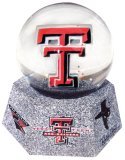Why We Collect Snow Globes

A Texas Tech Snow Globe, but not the much cooler one my friend James gave me.
Since I occasionally talk about snow globes here, I thought that I would fill you in on some of the Indiana snow globe lore.
Here is a piece I helped write for the spring 2003 Indiana University department of telecommunications alumni newsletter, Telecomment.
Telecom lab's formula for fun proves successful
Spring 2003
It's a Wednesday afternoon in early January, and classes don't begin for almost a week. Campus is quiet. However, at the Institute for Communication Research on the third floor of the Radio/TV Center, more than 20 people are gathered around the small conference table. Laughter spills out into the hallway as the assembled faculty and graduate students map out the upcoming semester.
Lab director and Telecom Professor Annie Lang sketches out each project in a notebook as the research assistants and other graduate students provide updates. But that's just part of the meeting. The other part is fun -- and lots of it. While the research planning goes on, visiting Assistant Professor T. Makana Chock passes around a box of chocolate macadamia nuts she brought back from Hawaii.
"I think that work should be fun," Lang said. "It's always my goal that we should do really good work in a really good atmosphere."
Perhaps the most revered presentation is when a new snow globe is unveiled. This lab tradition began several years ago when the current lab manager, Nancy Schwartz, was headed to London for spring break, and someone quipped, "Bring something back to decorate the lab."
Schwartz returned with a snow globe showing London's Big Ben and a double-decker bus, and the rest is lab history. Now every time a lab member presents a research paper at an academic conference, a new snow globe is purchased for the collection.
"Not only are they fun to look at and play with, it's a historical record of the lab members' ventures," Schwartz said.
Currently 43 snow globes sit atop the row of file cabinets in the lab. There would be more, but Lang put a moratorium on multiple snow globes from the same city.
Behind all of this fun -- indeed perhaps because of it -- is a lot of work. Various lab members submitted more than a dozen research papers for consideration at the upcoming ICA conference in San Diego, and that's just one of the three primary conferences at which the lab presents research each year. Faculty and students sent papers to a half-dozen other conferences during the past year.
Lang and her associates have always been productive, but the group was much smaller when she first came to IU.
"The lab used to run on love, on volunteers," Lang said. "Now a lot of students get financial support. But I'm trying to hire people who start out doing it because it's cool."
The number of lab members on the payroll has increased, but more and more volunteers pack into the lab for each new meeting. Johnny Sparks is in his first year of the Telecom PhD program. Sparks said he chose IU over other mass communications graduate programs because Telecom is a strong program, at a great university. But why was he attracted to the lab?
"The critical mass," Sparks replied.
In addition to Lang's growing reputation as an excellent mentor for talented young graduate students, the biggest change in the past few years has been the infusion of federal grant money. The lab is in the final year of a three-year, $375,000 grant from the National Institute on Drug Abuse to study the cognitive and emotional process ing of anti-drug public service announcements.
In October, the lab was awarded another $575,000 by NIDA to investigate the biological and psychological underpinnings of how people process these PSAs. The federal money has attracted international attention, too. Last fall, the lab was mentioned in Scientific American, and a French magazine sent a camera crew to photograph the lab in October.
As Lang is a strong mentor, so too are her proteges. She is continually recruiting students into the lab, and she says that she works to ensure that there are students from every level of graduate studies -- from doctoral students nearing completion of their dissertation to first-year master's students.
"I want everybody teaching each other. I don't want it to revolve around me. In the teaching you learn more," she said.
Second-year PhD student Byung-Ho Park said that he has benefited from both the teaching and learning functions of the lab:
"The senior students help new students to adapt to the environment and learn how to use the equipment and the underlying theories."
Former lab member and current Washington State University Assistant Professor Paul D. Bolls, Ph.D.,99, said the relationships formed in the lab didn't end when he received his Ph.D.
"The collaborative environment gave us the freedom to develop as researchers along with some friendships that will last the rest of our lives. We worked hard in the lab, but we also played hard!"
And, Bolls has carried the snow globe tradition to his own lab.
Speaking separately, former lab member and current University of Alabama Assistant Professor Rob Potter, Ph.D., 98, echoed the same sentiments.
"I'm sure at times the research seemed like work, but, looking back on it, I think more of the fun we had investigating stuff, learning about physiology, laughing and talking at weekly lab meetings and being productive," Potter said.
As the new semester begins, more than a half-dozen research projects are under way in the lab. And just to make sure the work doesn't get to be too much, there's often a party being planned.
The balance between work and play seems to be well calibrated for Telecom's Institute for Communication Research.




 FOLLOW SAM ON TWITTER
FOLLOW SAM ON TWITTER
 SUBSCRIBE TO THIS FEED
SUBSCRIBE TO THIS FEED

0 Comments:
Post a Comment
<< Home